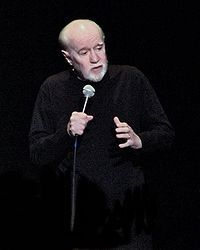Cross posted from The Stars Hollow Gazette
This is your morning Open Thread. Pour your favorite beverage and review the past and comment on the future.
Find the past “On This Day in History” here.
Click on images to enlarge
May 12 is the 132nd day of the year (133rd in leap years) in the Gregorian calendar. There are 233 days remaining until the end of the year.
 On this day in 1937, George Denis Patrick Carlin was born in the Bronx. He was raised by his mother in Morningside Heights which he and his friends called “White Harlem” because it sounded tougher. He was raised Irish Catholic and educated in Catholic schools. He often ran away from home. After joining the Air Force while stationed in Louisiana, Carlin became a DJ in Shreveport starting on his long career in entertainment. Carlin rose to fame during the 60’s and 70’s, generating the most controversy with his famous “Seven Dirty Words”:
On this day in 1937, George Denis Patrick Carlin was born in the Bronx. He was raised by his mother in Morningside Heights which he and his friends called “White Harlem” because it sounded tougher. He was raised Irish Catholic and educated in Catholic schools. He often ran away from home. After joining the Air Force while stationed in Louisiana, Carlin became a DJ in Shreveport starting on his long career in entertainment. Carlin rose to fame during the 60’s and 70’s, generating the most controversy with his famous “Seven Dirty Words”:
Shit, Piss, Fuck, Cunt, Cocksucker, Motherfucker, and Tits. Those are the heavy seven. Those are the ones that’ll infect your soul, curve your spine and keep the country from winning the war.
His arrest and the subsequent FCC rulings ended up in the Supreme Court which upheld the right of the FCC to regulate the public airways. In the ruling it called the routine “indecent but not obscene”.
In 1961, Carlin was also present in the audience the night that Lenny Bruce was arrested in San Fransisco for obscenity. He was arrested, as well, after the police, who were questioning the audience, asked Carlin for ID. He said he didn’t have any because he didn’t believe in government-issued ID’s.
We all know the rest. His popularity as a comic and “commentarian” on politics, religion and social issues made him a popular guest on late night talk shows. His death in June 22, 2008 saddened many. He left behind his second wife, Sally Wade, whom he married after his first wife Brenda died of liver cancer in 1997. He left a daughter by his first marriage, Kelly.
Happy Birthday, George, you are missed.


 On this day in 1934,
On this day in 1934, 



 On this day in 1973,
On this day in 1973,